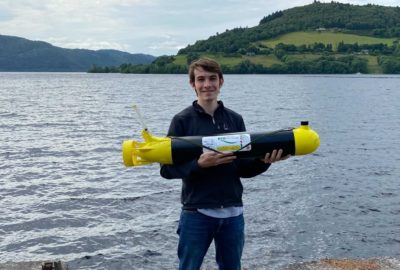Can we build an eco-friendly aeroplane?
Wednesday 14th Apr 2021, 1.36pm
Remember those days when it was possible to climb aboard a plane and jet off around the world? Well, while we might be yearning for foreign shores, there’s no denying that air travel comes with a big ol’ carbon footprint. But is it possible to make aeroplanes ‘greener’? We chat to Dr Chiara Falsetti, a researcher at the Oxford Thermofluids Institute, who is looking at ways to improve the cooling mechanisms of aircraft engines, to boost their efficiency and ultimately make flying more sustainable.
Emily Elias: Remember flying? Remember getting on one of those big old airplanes and getting transported to somewhere else in the world? Well, those planes aren’t necessarily the greenest thing that we could be doing. I mean, they’re not great for combatting climate change. So, on this episode of the Oxford Sparks Big Questions podcast, we are asking, can we build an eco-friendly airplane?
Hello, I’m Emily Elias and this is the show where we seek out the brightest minds at the University of Oxford and we ask them the big questions. For this one, we’ve found a researcher who loves big engines and she cannot lie.
Chiara Falsetti: Hello. I am Chiara Falsetti and I work as a postdoc researcher at the Oxford Thermofluids Institute.
Emily: You study jet engines?
Chiara: Yes.
Emily: Do you remember the first time that you saw one?
Chiara: Yes, I do remember that moment. I think I was eight and I was flying with my parents to the Red Sea in Egypt. I remember I was so impressed by the big engines and excited about it and I felt like an astronaut going into space, rather than just flying, really.
Emily: So, I guess that magic hasn’t gone away?
Chiara: So, when I was a younger female student, I was impressed by the technology of airplanes and I was thinking, “How can we improve these technologies?” From the beginning of when the aircraft were invented, I surprised on the technological advances during this century, so I’m interested in keeping improving aircraft engines.
Emily: The first commercial flight was the de Havilland Comet in 1949. Its design was revolutionary. It had 4 large turbine jet engines and it was sleek and futuristic compared to these old propellor-driven airplanes, but this plane had some major flaws. Still, it changed aviation forever. We’ve seen some major improvements to aircraft and Chiara wants to make sure that the next generation of planes are even better for the planet.
Chiara: So, basically, what is much improved is the materials that are used and, also, the aircraft engines are improved quite a lot in terms of efficiency, but I think we have, still, a lot to do to, let’s say, improve them, to protect the planet from the disastrous impacts of climate change.
Emily: Yes. I mean, obviously, flying a plane isn’t the greenest activity that’s going on.
Chiara: Yes. Let’s say the transport sector has a huge impact on CO2 emissions, but I think stopped or heavily reduced flying would have a great consequence for people, jobs and economies all over the world. So, I think stop flying would be a step backwards to an isolated society that is smaller, poorer and constrained. So, I say let’s work together to make flying sustainable, so improve them, rather than stop them.
Emily: Is it even possible? I mean, it feels like an oxymoron to talk about green airplanes.
Chiara: Exactly. So, basically, we have some targets and goals to achieve in the next years, for example. We have to improve the efficiency of the engines, but also try to promote novel technologies and also infrastructure improvements, including air traffic management systems and also more efficient aircraft operations.
Emily: So, you are specifically focusing on the engines. Is there room to improve them?
Chiara: Yes. In this area, there are many different ways to improve the efficiency on our aircraft engines and we are trying to improve the cooling systems in order to reduce the CO2 emissions of an engine, but there are other many interesting areas to develop.
Emily: So, I mean, I’m no engineer, but how does a jet engine that you see strapped to an airplane, how does that actually work?
Chiara: So, it’s a number of steps from sucking air, and then compress it, and then mix it with fuel and then expand it, creating the net force that is pushing us.
Emily: So, that’s all happening really, really, really, really, really fast.
Chiara: Yes, exactly. This is happening fast and in a very compressed space.
Emily: So, there has got to be some heat generated from this superfast movement, right? Like, how hot does it get?
Chiara: Well, there are several engines that have a different size and may have slightly different components, but, generally, the temperatures can go up to 2,000°C. So, the metals have to stand very high temperatures that are above the metal melting point and they have to stand very harsh thermal conditions.
Emily: That’s insane. Okay. So, is there a worry that these metals could melt?
Chiara: Yes. Well, these temperatures are capable of melting metals. So, you basically have to find a way to cool down the blades and all the components of your engines if you don’t want your motor to melt.
Emily: Yes. I don’t think anybody wants a jet engine to melt. Okay. So, you’ve got this, like, raging hot jet engine and you have to keep it cool. How do you do that?
Chiara: So, we have to keep the temperature at a much lower value than the melting point of the metals, of course, because you want to have a high safety factor, right? You don’t want to reach the temperature or even go nearby that value. So, what we are trying to do is to develop advanced cooling technologies that basically use part of the air that is sucked upstream the engine and a part of that air is used to cool down the components, like the rotating blades.
So, we machine very small holes on the outer casing, but also on the blades of the turbine. This air that is cold, much colder than the air coming from the combustion chamber, is then spilled into these holes and the cold air is creating a film that is protecting the materials. So, imagine you have the hot stream coming from your combustion chamber that is, basically, instead of touching directly the surface of the blades, the surfaces are protected by a film of cold air that is spilled through the holes.
Emily: Again, I mean, this sounds insane to me. Okay. So, you have these little holes that you machine in. So, when you guys are making improvements, what does that actually mean? Are you messing around with these little holes?
Chiara: Yes. So, improvements can be made by looking at this technology that I just explained and trying to make it more efficient, because, for example, the cold air coming from the holes can have also a negative impact because it can, for example, augment the pressure drop inside the motor. So, we want to make it more efficient also from an aerodynamic point of view. So, that is what we are doing right now, but another interesting area would be to start thinking about a completely different engine and moving towards a more electric or hybrid engines.
Emily: Getting these engines more efficient is the key to this whole climate change thing?
Chiara: If you improve the efficiency of an engine, you can reduce the CO2 emissions. So, basically, you are making your aircraft more efficient and that’s more green.
Emily: So, in your lab, you’re testing out these engines and the configurations of these tiny holes. That’s pretty much what you’re doing all day.
Chiara: We have our section of our aircraft engine that is able to test representative conditions, flight conditions. So, we spin our motor, like when you are flying with an aircraft, and then we have all the instrumentations that are able to catch the temperature and the pressure inside the motor, okay, while the blades are rotating. We are basically measuring all the temperature and pressure values with and without cooling holes, for example, and then compare the results to see, “Okay, then. Our cooling system is working better than the previous one or what can we do to improve it further?”
Emily: Do you think, one day, that we will have a greener airplane that, like, I could fly to Canada on that is super-efficient or even electric?
Chiara: So, that’s a big question and it is really connected to how the batteries can be developed so far because, as you understand, batteries are the main core of an electric aircraft, right? So, if your batteries can last longer and be more powerful, then we will be able to make an electric aircraft. For now, there is a lot of work going on in the automotive sector, but the aeronautical sector is following as well.
Emily: Okay. So, maybe I’m a bit ahead of myself, but it has got to be pretty exciting to know that every test that you do, you are getting closer to making a positive change for this planet and you are helping to fight climate change.
Chiara: That’s basically what pushed me into research, really, because I think, as a researcher, but also as engineers, we have the possibility of shaping the society of tomorrow because our society now is really connected to technologies, is more and more connected to the technologies that we are developing. So, that’s really the big reward of our job, being able to improve existing technologies and, by that, shaping the society of tomorrow.
Emily: This podcast was brought to you by Oxford Sparks from the University of Oxford with music by John Lyons and a special thanks to Chiara Falsetti. Tell us what you think about this podcast. You can go to Twitter or tweet us at @OxfordSparks, you can find us on Facebook or anywhere else that you’re hanging out. Plus, we’ve got a website oxfordsparks.ox.ac.uk. I’m Emily Elias. Bye for now.




